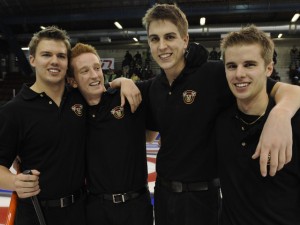The Last End: Opportunities for Junior Curlers
The first official Canadian schoolboys curling championship took place back in 1950 and for the next 25 years the age limit was 18 and Canada’s high schools played a major role in its operation.
But it would seem that all good things come to end. And so it was that the connection between junior men’s curling and the education system ended after the 1975 season.
I still find myself correcting people who blame the Canadian Curling Association for “taking curling away from the schools.” It wasn’t the CCA. Frankly, it had nothing to do with the CCA or any of its member associations.
 You see, back in those days, a national organization — known as the High School Athletic Federation — was responsible for overseeing the operation of sports within Canada’s high schools. It was the federation, in fact, that decided that schools shouldn’t be involved in any sporting activity that would lead the winners to participate in a national championship. It was thought it was counter-productive to take students out of school for more than a week. And because the national championship was a school-endorsed activity, a teacher had to accompany each team. As a result, the teacher was also lost to the system for a week.
So when the last stone came to rest at the 1975 schoolboys championship at the Derrick Golf and Winter Club in Edmonton and Alberta’s Paul Gowsell hoisted the champion’s trophy, the Canadian Curling Association’s affiliation with the Canadian high-school system ended.
Looking back at some of the minutes of meetings of the day, it’s apparent the change from schoolboy to junior status did not happen without differences of opinion:
You see, back in those days, a national organization — known as the High School Athletic Federation — was responsible for overseeing the operation of sports within Canada’s high schools. It was the federation, in fact, that decided that schools shouldn’t be involved in any sporting activity that would lead the winners to participate in a national championship. It was thought it was counter-productive to take students out of school for more than a week. And because the national championship was a school-endorsed activity, a teacher had to accompany each team. As a result, the teacher was also lost to the system for a week.
So when the last stone came to rest at the 1975 schoolboys championship at the Derrick Golf and Winter Club in Edmonton and Alberta’s Paul Gowsell hoisted the champion’s trophy, the Canadian Curling Association’s affiliation with the Canadian high-school system ended.
Looking back at some of the minutes of meetings of the day, it’s apparent the change from schoolboy to junior status did not happen without differences of opinion:

Geoff Chambers, Jake Walker, Craig Van Ymeren and Matthew Mapletoft of Team Ontario at the 2010 M&M Meat Shops Canadian Juniors (Photo: CCA/Michael Burns Photography)
- One delegate saw curling as an incentive that kept boys in school. Another argued that a large number of boy curlers were forced out of school for economic reasons and they should not be excluded from competition because of this.
- There was concern about the need for the CCA and provincial associations to support junior programs developed by clubs.
- Fear was expressed that taking the program away from the schools would hurt junior curling in provinces where “headmasters” controlled school curling.
- One committee member claimed the change to junior status would merely expand the number of those eligible to play.
- Others argued the change would only strengthen the competition, which would “still retain its old schoolboy tie.”




